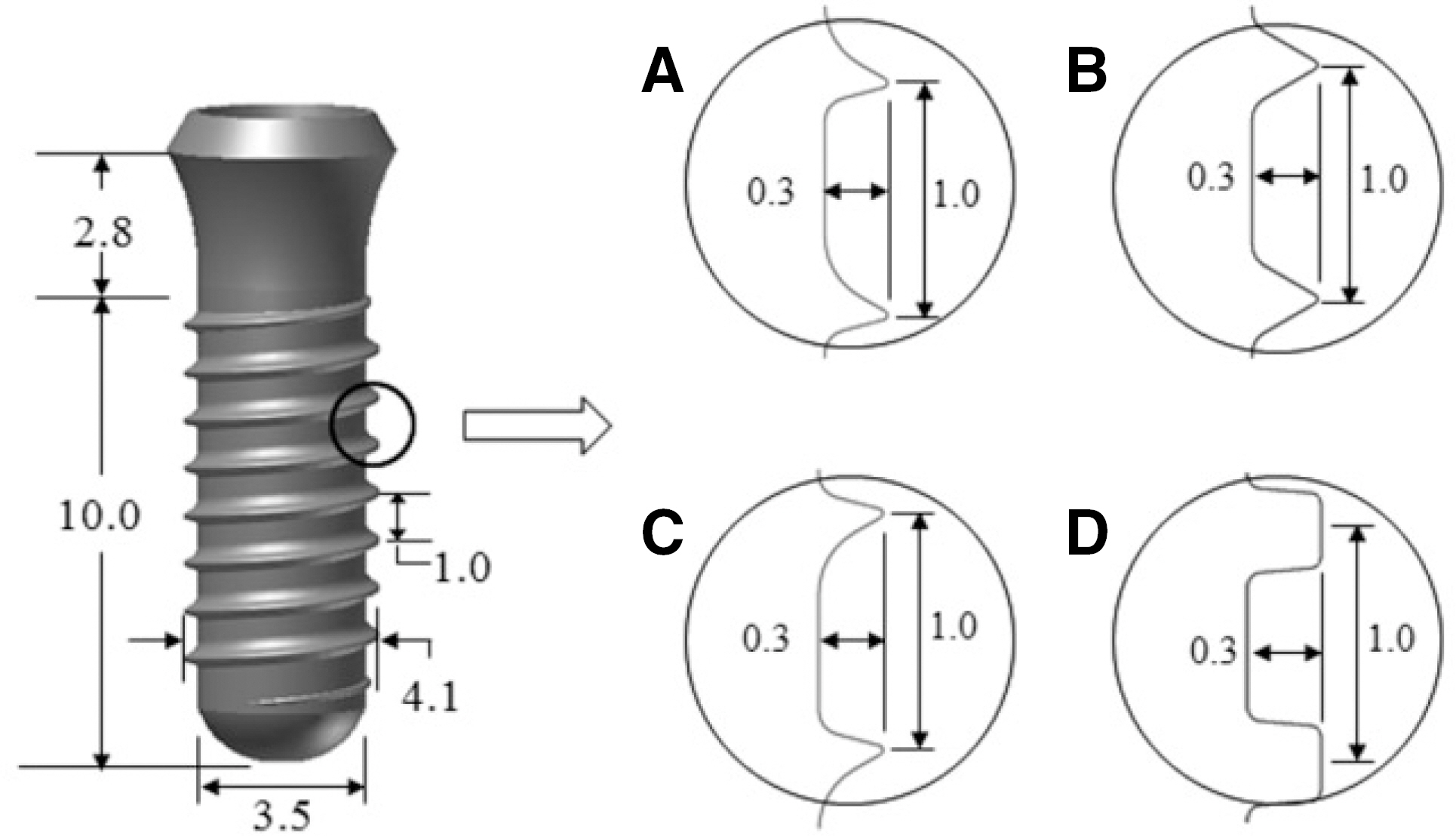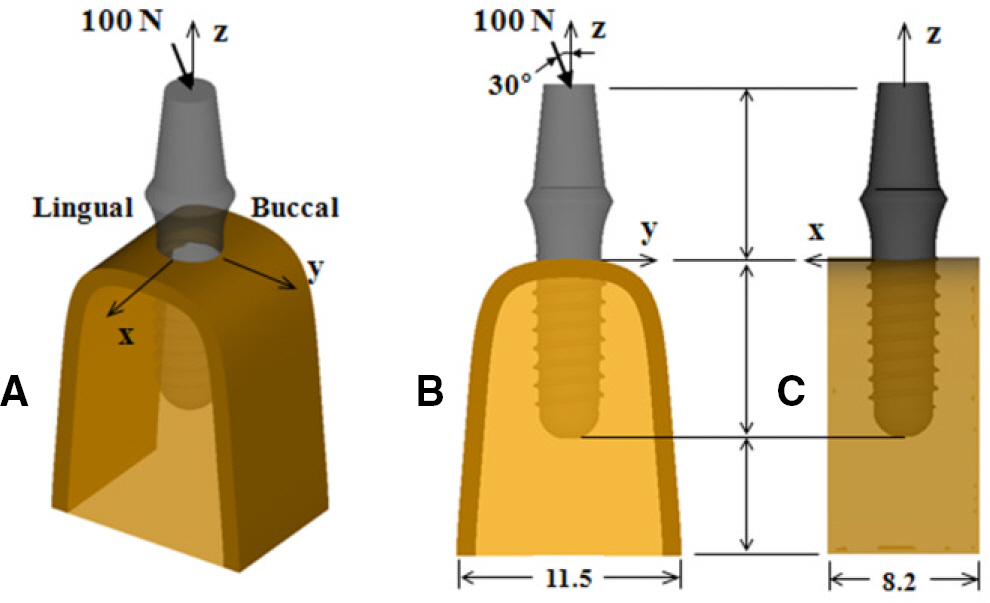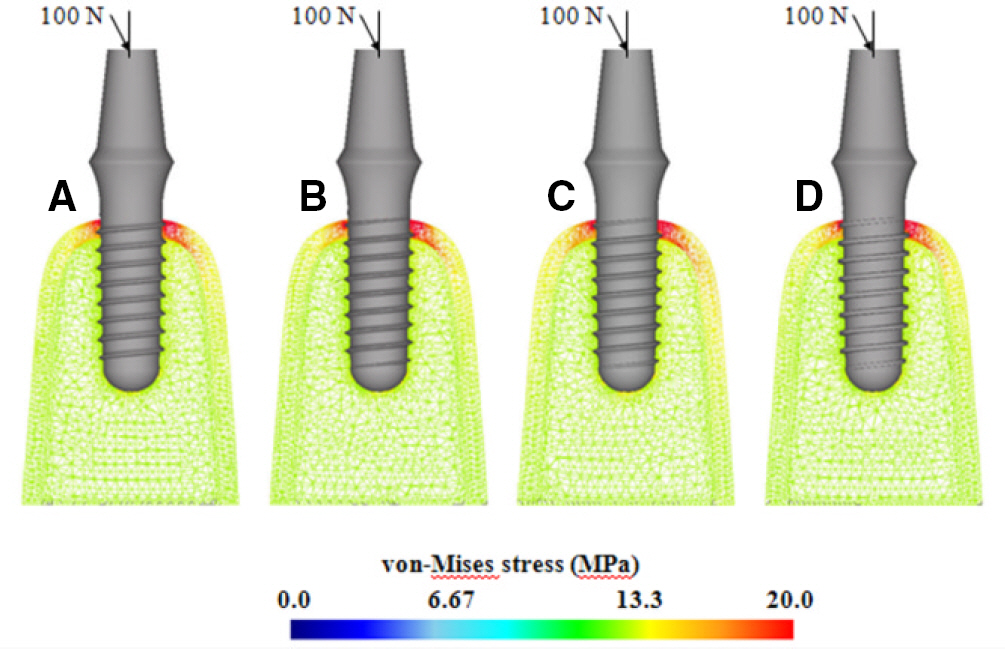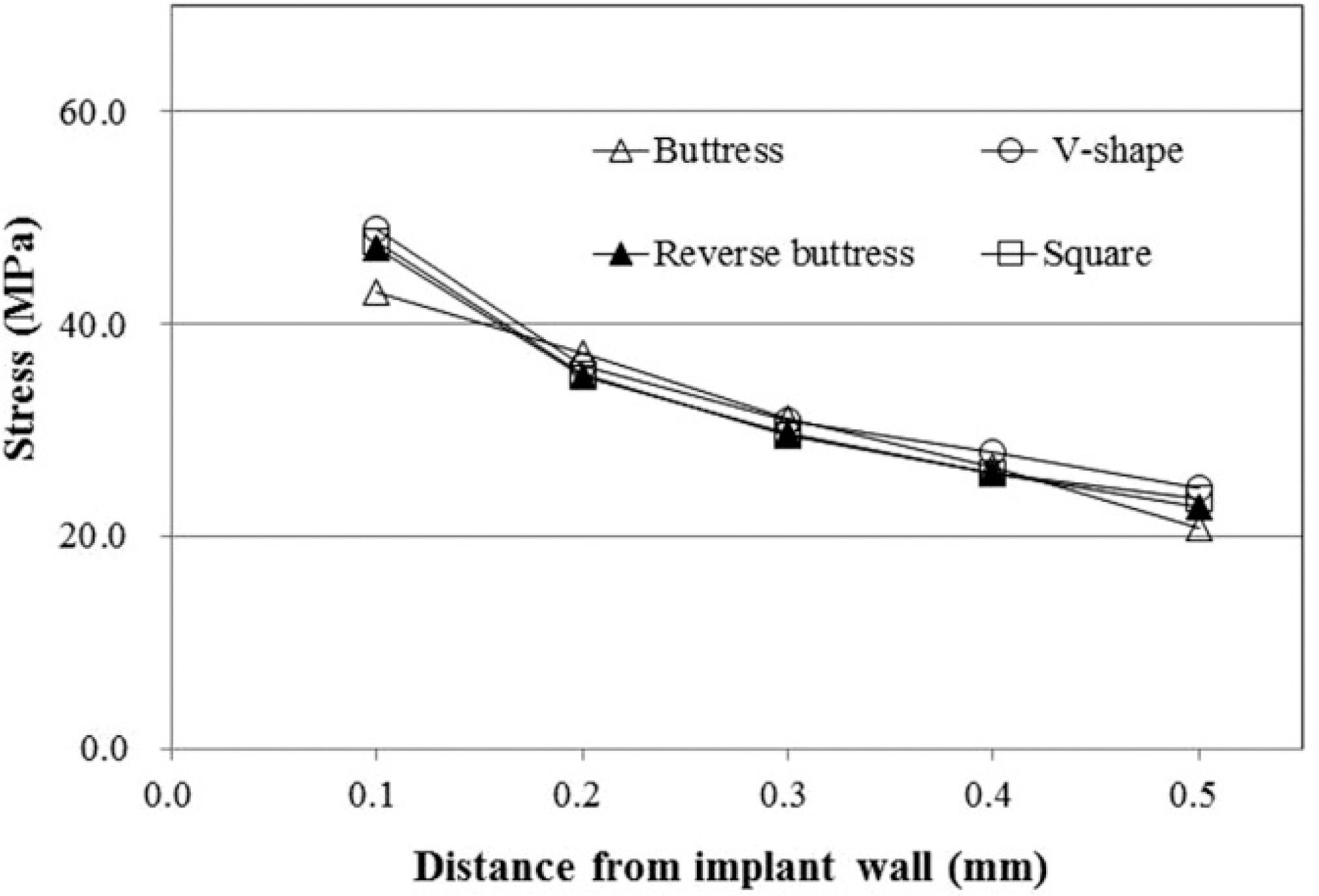J Korean Acad Prosthodont.
2015 Apr;53(2):120-127. 10.4047/jkap.2015.53.2.120.
Stress dissipation characteristics of four implant thread designs evaluated by 3D finite element modeling
- Affiliations
-
- 1Department of Dentisty, Busan Paik Hospital, Inje University, Busan, Republic of Korea.
- 2Department of Orthodontics, School of Dentistry, Kyungpook National University, Daegu, Republic of Korea. wonjaeyu@knu.ac.kr
- KMID: 2195394
- DOI: http://doi.org/10.4047/jkap.2015.53.2.120
Abstract
- PURPOSE
The aim was to investigate the effect of implant thread designs on the stress dissipation of the implant.
MATERIALS AND METHODS
The threads evaluated in this study included the V-shaped, buttress, reverse buttress, and square-shaped threads, which were of the same size (depth). Building four different implant/bone complexes each consisting of an implant with one of the 4 different threads on its cylindrical body (4.1 mm x 10 mm), a force of 100 N was applied onto the top of implant abutment at 30degrees with the implant axis. In order to simulate different osseointegration stages at the implant/bone interfaces, a nonlinear contact condition was used to simulate immature osseointegration and a bonding condition for mature osseointegration states.
RESULTS
Stress distribution pattern around the implant differed depending on the osseointegration states. Stress levels as well as the differences in the stress between the analysis models (with different threads) were higher in the case of the immature osseointegration state. Both the stress levels and the differences between analysis models became lower at the completely osseointegrated state. Stress dissipation characteristics of the V-shape thread was in the middle of the four threads in both the immature and mature states of osseointegration. These results indicated that implant thread design may have biomechanical impact on the implant bed bone until the osseointegration process has been finished.
CONCLUSION
The stress dissipation characteristics of V-shape thread was in the middle of the four threads in both the immature and mature states of osseointegration.
Figure
Reference
-
1. Albrektsson T, Brå nemark PI, Hansson HA, Lindströ m J. Osseointegrated titanium implants. Requirements for ensuring a long-lasting, direct bone-to-implant anchorage in man. Acta Orthop Scand. 1981; 52:155–70.2. Friberg B, Jemt T, Lekholm U. Early failures in 4, 641 consec-utively placed Brå nemark dental implants: a study from stage 1 surgery to the connection of completed prostheses. Int J Oral Maxillofac Implants. 1991; 6:142–6.3. Javed F, Ahmed HB, Crespi R, Romanos GE. Role of primary stability for successful osseointegration of dental implants: Factors of influence and evaluation. Interv Med Appl Sci. 2013; 5:162–7.
Article4. Kim SH, Kim S, Lee KW, Han DH. The effects of local factors on the survival of dental implants: A 19 year retrospective study. J Korean Acad Prosthodont. 2010; 48:28–40.
Article5. Meredith N. Assessment of implant stability as a prognostic de-terminant. Int J Prosthodont. 1998; 11:491–501.6. Misch CE. Dental implant prosthetics. St. Louis: Mosby;2005. p. 322–47.7. Chun HJ, Cheong SY, Han JH, Heo SJ, Chung JP, Rhyu IC, Choi YC, Baik HK, Ku Y, Kim MH. Evaluation of design parameters of osseointegrated dental implants using finite element analysis. J Oral Rehabil. 2002; 29:565–74.
Article8. Kong L, Hu K, Li D, Song Y, Yang J, Wu Z, Liu B. Evaluation of the cylinder implant thread height and width: a 3-dimensional finite element analysis. Int J Oral Maxillofac Implants. 2008; 23:65–74.9. Seo YH, Vang MS, Yang HS, Park SW, Park HO, Lim HP. Three-dimentional finite element analysis of stress distribution for different implant thread slope. J Korean Acad Prosthodont. 2007; 45:482–91.10. Hansson S, Werke M. The implant thread as a retention element in cortical bone: the effect of thread size and thread profile: a finite element study. J Biomech. 2003; 36:1247–58.
Article11. Geng JP, Ma QS, Xu W, Tan KB, Liu GR. Finite element analysis of four thread-form configurations in a stepped screw implant. J Oral Rehabil. 2004; 31:233–9.
Article12. Esposito M, Thomsen P, Ericson LE, Lekholm U. Histopathologic observations on early oral implant failures. Int J Oral Maxillofac Implants. 1999; 14:798–810.13. Raghavendra S, Wood MC, Taylor TD. Early wound healing around endosseous implants: a review of the literature. Int J Oral Maxillofac Implants. 2005; 20:425–31.14. Yu WJ, Ha SJ, Cho JH. Effects of implant thread profile on insertion stress generation in cortical bone studied by dynamic finite element simulation. J Korean Acad Prosthodont. 2014; 52:279–86.
Article15. Schwitalla AD, Abou-Emara M2, Spintig T, Lackmann J2, Mü ller WD3. Finite element analysis of the biomechanical effects of PEEK dental implants on the peri-implant bone. J Biomech. 2015; 48:1–7.16. Van Oosterwyck H, Duyck J, Vander Sloten J, Van der Perre G, De Cooman M, Lievens S, Puers R, Naert I. The influence of bone mechanical properties and implant fixation upon bone loading around oral implants. Clin Oral Implants Res. 1998; 9:407–18.
Article17. Sevimay M, Turhan F, Kiliç arslan MA, Eskitascioglu G. Three-dimensional finite element analysis of the effect of different bone quality on stress distribution in an implant-supported crown. J Prosthet Dent. 2005; 93:227–34.
Article18. Papavasiliou G, Kamposiora P, Bayne SC, Felton DA. 3D-FEA of osseointegration percentages and patterns on implant-bone interfacial stresses. J Dent. 1997; 25:485–91.
Article19. Huang HL, Hsu JT, Fuh LJ, Tu MG, Ko CC, Shen YW. Bone stress and interfacial sliding analysis of implant designs on an immediately loaded maxillary implant: a nonlinear finite element study. J Dent. 2008; 36:409–17.
Article20. Mellal A, Wiskott HW, Botsis J, Scherrer SS, Belser UC. Stimulating effect of implant loading on surrounding bone. Comparison of three numerical models and validation by in vivo data. Clin Oral Implants Res. 2004; 15:239–48.21. Rubin PJ, Rakotomanana RL, Leyvraz PF, Zysset PK, Curnier A, Heegaard JH. Frictional interface micromotions and anisotrop-ic stress distribution in a femoral total hip component. J Biomech. 1993; 26:725–39.
Article22. Albrektsson T, Berglundh T, Lindhe J. Osseointegration: Historic background and current concepts. Lindhe J, Karring T, Lang NP, editors. Clinical periodontology and implant dentistry. Oxford: Blackwell Munksgaard;2003. p. 809–20.23. Davies JE. Mechanisms of endosseous integration. Int J Prosthodont. 1998; 11:391–401.24. Viceconti M, Muccini R, Bernakiewicz M, Baleani M, Cristofolini L. Large-sliding contact elements accurately predict levels of bone-implant micromotion relevant to osseointegration. J Biomech. 2000; 33:1611–8.
Article25. Wehner T, Penzkofer R, Augat P, Claes L, Simon U. Improvement of the shear fixation stability of intramedullary nailing. Clin Biomech (Bristol, Avon). 2011; 26:147–51.
Article26. Bardyn T, Gé det P, Hallermann W, Bü chler P. Prediction of dental implant torque with a fast and automatic finite element analysis: a pilot study. Oral Surg Oral Med Oral Pathol Oral Radiol Endod. 2010; 109:594–603.
Article27. Lin D, Li Q, Li W, Ichim I, Swain M. Evaluation of dental implant induced bone remodelling by using a 2D finite element model. Proceedings of the 5th Australasian Congress on Applied Mechanics (ACAM 2007). 2007 Dec 10-12. Brisbane; Australia;. 301–6.28. Atieh MA, Shahmiri RA. Evaluation of optimal taper of immediately loaded wide-diameter implants: a finite element analysis. J Oral Implantol. 2013; 39:123–32.
Article29. Frost HM. Bone's mechanostat: a 2003 update. Anat Rec A Discov Mol Cell Evol Biol. 2003; 275:1081–101.
Article30. Geng JP, Ma QS, Xu W, Tan KB, Liu GR. Finite element analysis of four thread-form configurations in a stepped screw implant. J Oral Rehabil. 2004; 31:233–9.
Article31. Kong L, Liu B, Li D, Song Y, Zhang A, Dang F, Qin X, Yang J. Comparative study of 12 thread shapes of dental implant designs: a three-dimensional finite element analysis. World J Model Simul. 2006; 2:134–40.
- Full Text Links
- Actions
-
Cited
- CITED
-
- Close
- Share
- Similar articles
-
- The Three Dimensional Finite Element Analysis of Stress according to Implant Thread Design under the Axial Load
- The three dimensional finite element analysis of the stress distribution according to the implant and thread designs
- Effects of implant thread profile on insertion stress generation in cortical bone studied by dynamic finite element simulation
- Three-dimentional finite element analysis of stress distribution for different implant thread slope
- Three-dimensional finite element analysis of stress distribution for different implant thread slope and implant angulation







